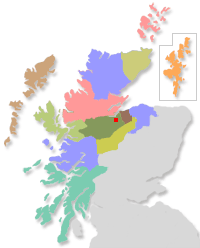Ross and Cromarty stretches across a considerable area of the Highlands, from north of Inverness to Kincardine in the east, and from Glenshiel to beyond Ullapool in the west. The population of the area stands at around 50,000 people, most of it spread amongst rural areas and smaller settlements.
The significant settlements in the area, include Cromarty, Fortrose, Munlochy, Conon Bridge, Dingwall, Evanton, Alness, Invergordon, Tain, Marybank, Strathpeffer, Ullapool, Aultbea, Poolewe and Gairloch. Along with many smaller villages.
Inverness Airport provides the closest link for international transport and is less than a 2 hour drive from most of Ross and Cromarty, significantly closer from many settlements in the east. The main road link south is the A9 via Inverness (around 3 hours from Inverness to Glasgow and Edinburgh), or the A82 via Fort William (around 2 hours 30 minutes from Fort William to Glasgow). There are also train services running from Inverness to Thurso in the east and from Inverness to Kyle of Lochalsh in the west.
Ross and Cromarty boasts a wide variety of attractive settlements in picturesque locations, from the villages of Cromarty and Tain in the east to Gairloch and Ullapool in the west. Much of the economy in the area is based on tourism and there are many attractions for visitors and locals to enjoy including the stunning Inverewe Gardens in Poolewe, Balblair Distillery in Tain, Ullapool’s annual Loopallu Music Festival and dolphin watching at Chanonry Point, to name just a few.
The area is also rightly famous for its stunning landscapes, the mountains and beaches are viewed by many as amongst the most beautiful in Europe, particularly the impressive glen of Torridon which is a favourite spot for sightseers, geologists and hillwalkers alike. The area is also renowned for its interesting variety of wildlife with the recently reintroduced Sea Eagles being of particular interest to nature lovers and bird watchers.

Ross and Cromarty has a long history, the rock which makes up the geology of the area contains some of the oldest formations in the world, geologists are still attracted to the area to study the interesting landscapes. More recently the population of the area was heavily affected by the defeat of the 1745 Jacobite uprising and the clearances and emigration from the Highlands in the years after.
- Achiltibuie
- Achnasheen
- Alness
- Applecross
- Arabella
- Ardival
- Ardross
- Aultbea
- Avoch
- Balblair
- Balintore
- Barbaraville
- Black Isle
- Braes
- Braes of Conon
- Conon Bridge
- Contin
- Craigton
- Cromarty
- Culbokie
- Cullicudden
- Curin
- Davidston
- Delny
- Dingwall
- Duncanston
- Dundonnell
- Easter Cullicudden
- Edderton
- Evanton
- Fearn
- Fendom
- Fortrose
- Gairloch
- Garve
- Hill of Fearn
- Hilton of Cadboll
- Inver
- Inver Alligin
- Inveralligin
- Inverasdale
- Invergordon
- Jemimaville
- Kilcoy
- Kildary
- Killen
- Kinlochewe
- Kishorn
- Laide
- Little Garve
- Loch Broom
- Loch Maree
- Loch Ussie
- Lochcarron
- Lochluichart
- Marybank
- Maryburgh
- Mellon Udrigle
- Milton of Kildary
- Muir of Ord
- Muir of Tarradale
- Mulbuie
- Munlochy
- Nigg
- Nigg Station
- North Kessock
- Plockton
- Poolewe
- Portmahomack
- Poyntzfield
- Rosemarkie
- Scoraig
- Scotsburn
- Shandwick
- Shieldaig
- South Erradale
- Strathcarron
- Strathconon
- Strathpeffer
- Tain
- Tarvie
- Teaninich
- Tore
- Torridon
- Ullapool
- Wester Cullicudden
- Search Form
- Map Search
-
You can draw a search area on a map, or click a location below.

- Recently Added Properties
- New in the Last 3 Days New this Week New this Fortnight Recent Updates All Our Properties
- Special Searches
-
New Build Properties
Property with a Paddock
Commercial Property
- My HSPC
- Property MatchYour Preferences
- Highland Solicitors Property Centre Local knowledge. A world of difference.
- Visit our property centre at 30 Queensgate, Inverness, IV1 1DJ
Company number: SC099700
Registered Office: 30 Queensgate, Inverness, IV1 1DJ - 01463 231173








